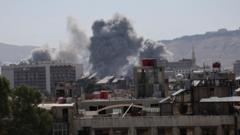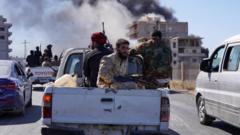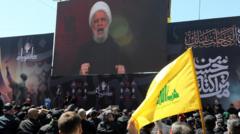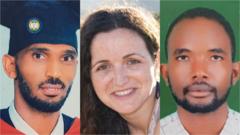In a moment of high visibility, Iranian Supreme Leader Ayatollah Ali Khamenei made his first public appearance since the onset of the conflict with Israel, marking a significant event broadcasted by state media. This appearance took place during a ceremony at a Tehran mosque on Saturday, just before the Shia festival of Ashura. Khamenei had previously addressed the nation only through recorded messages during the 12-day war that began on June 13, which claimed the lives of several high-profile Iranian military figures and scientists due to Israeli airstrikes.
Iran Supreme Leader Emerges Publicly Amid Ongoing Israel Conflict

Iran Supreme Leader Emerges Publicly Amid Ongoing Israel Conflict
Ayatollah Ali Khamenei's first public appearance since the Israel war has sparked significant attention in Iran and beyond.
During the conflict, where fears of Khamenei's safety led to speculation about him hiding in a bunker, he delivered several video statements that proclaimed Iran's resilience. Following a ceasefire on June 26, Khamenei openly declared Iran's "victory" against the backdrop of U.S. military involvement that saw airstrikes on Iranian nuclear sites. President Donald Trump remarked on Khamenei's statements, asserting the destruction of Iran's nuclear capabilities, further escalating tensions.
Khamenei's latest public presence has been widely covered in Iranian media, capturing scenes of supporters celebrating this moment. He encouraged the gathering to sing a patriotic song, representative of national spirit during the recent hostilities. Additionally, Iranian state television has invited citizens to share their reactions to Khamenei's public return, reflecting the political significance of this occasion.
His appearance coincides with the month of Muharram, a period of mourning observed by the predominantly Shia Muslim population, culminating in Ashura on July 6—an event mourned for the martyrdom of Imam Hossein. The recent conflict has been described profoundly, with Iranian judiciary stating over 900 people lost their lives during the hostilities, while analysts continue to assess the implications of these developments on both domestic and regional levels.
As Iran grapples with the aftermath of the Israel conflict, Khamenei's exchange with supporters and his narrative of resilience may shape the country's trajectory in the evolving landscape of Middle Eastern geopolitics.
Khamenei's latest public presence has been widely covered in Iranian media, capturing scenes of supporters celebrating this moment. He encouraged the gathering to sing a patriotic song, representative of national spirit during the recent hostilities. Additionally, Iranian state television has invited citizens to share their reactions to Khamenei's public return, reflecting the political significance of this occasion.
His appearance coincides with the month of Muharram, a period of mourning observed by the predominantly Shia Muslim population, culminating in Ashura on July 6—an event mourned for the martyrdom of Imam Hossein. The recent conflict has been described profoundly, with Iranian judiciary stating over 900 people lost their lives during the hostilities, while analysts continue to assess the implications of these developments on both domestic and regional levels.
As Iran grapples with the aftermath of the Israel conflict, Khamenei's exchange with supporters and his narrative of resilience may shape the country's trajectory in the evolving landscape of Middle Eastern geopolitics.





















